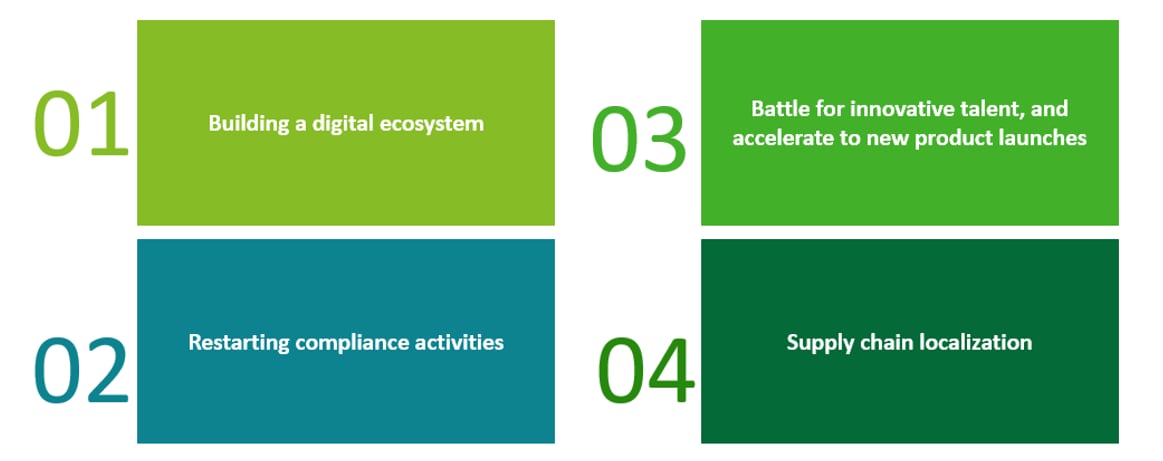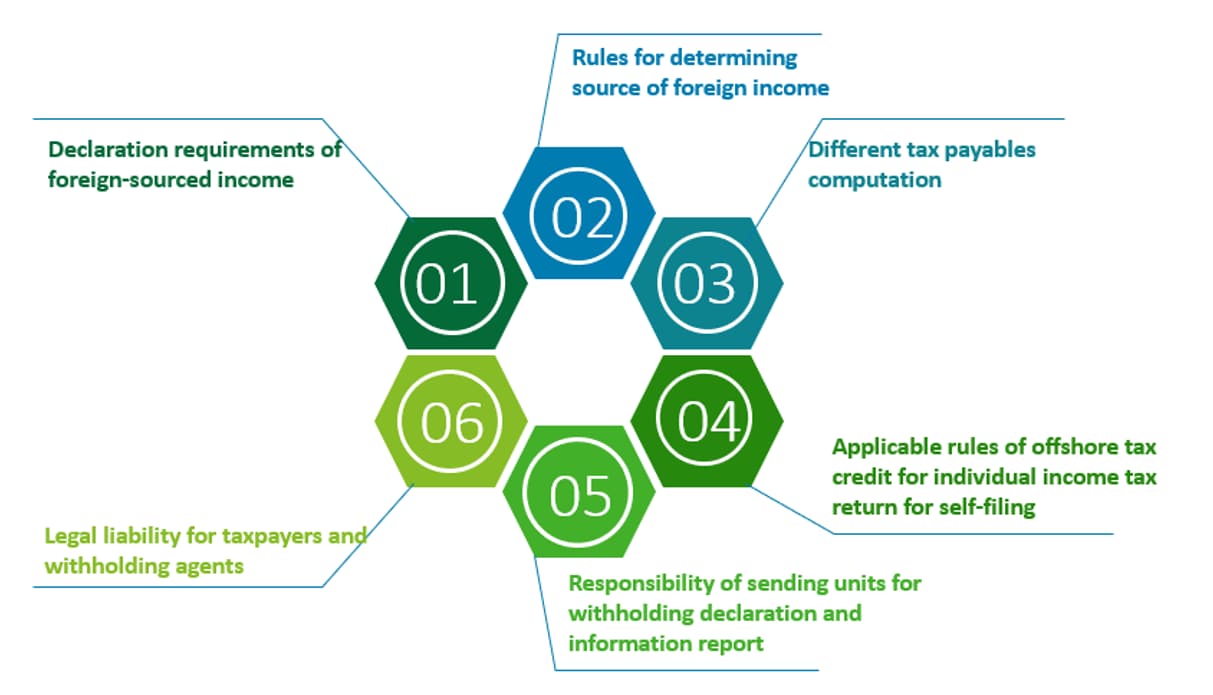Article

Deloitte 2023 Q2 CFO Express
Issue No. 10
Published: 31 May 2023
Explore Content
- Play this episode
- Consumption gets a boost but still room for monetary easing
- 2023 Tech Trends
- The implications of Generative AI for business
- Post Covid Industry Trends - Consumer Products and Retail Industry Overview 2023
- China LSHC Industry Survey Results: 2023 State of Industry in China
- Global IFRS 17 Survey 2022
- Interpretations for fully-digitalized electronic invoices (FEDIs) process management guidelines
- Challenges and considerations for overseas dispatch management
- For newly hired CFOs, building a sturdy talent framework may take seven pillars
It is pointed out on a Politburo meeting on April 2023 that increasing aggregated demand is the key to maintain Chinese economy momentum in the long run, and therefore policies must be optimal to stabilize property market and further improve consumer confidence. The recent “revenge consumption” and resilient consumers, as well as the outperforming exports, provide strong evidence for China’s economic recovery, but future market rebound will still rely on continued supportive measures. If vigorous recovery continues, we suggest that 2023 growth is likely to be comfortably above the government’s target of “around 5%”. While steady rebound from consumer market may restore confidence of the private sector, innovation, stability of industry chains, and digital transformation remain to be key priorities for businesses. Businesses need to be aligned with policy updates, develop and innovate business models while building capacities related to technical upgrade, organizational transformation, leadership succession and talent development.
This issue of CFO Express provides insights on industry trends and disruptions that organizations currently face. It includes cross-domain application of Generative AI, 2023 outlooks on consumer products and retail and LSHC industry, as well as analyses on financial hot topics such as IFRS 17 implementation and fully digitalized e-invoicing (FDEIs) process management. It also covers topics from human resources, such as challenges and considerations for overseas dispatch management and key pillars for building sturdy talent framework. We hope finance executives and their colleagues find these excerpts instructive.
Chief Economist’s View |
|
Trends and Outlook |
|
Expertise and Practice |
|
Talent and development |
 Chief Economist's View
Chief Economist's View
Consumption gets a boost but still room for monetary easing
Deloitte Chief Economist, Sitao Xu, share his perspectives on China’s economic outlook for the first half of 2023. His main takeaways are:
- Thanks to its resilient consumers and outperforming exports, China’s economy has currently seen vigorous recovery. A key hypothesis underpinning China’s recovery in 2023 is “revenge consumption”, as shown by the travel boom during May holiday. More supportive measures are still needed to further enhance consumer confidence and consumption.
- The policy of getting people to upgrade their homes is central to boost consumption. Many property developers in China have seen their financing costs fall sharply since a slew of supportive measures dished out by the government, but developers are unlikely to ramp up investment unless new homes are being sold more convincingly.
- The core focus for reflation in China ought to be focusing on the property market. From this perspective, the Fed’s signal of leaving interest rates on hold should give the PBOC more wiggle room for its targeted easing. Increasing aggregate demand is key for economy rebound, an easier monetary stance should be on the cards.

More information: Consumption gets a boost but still room for
monetary easing
 Trends and Outlook
Trends and Outlook
2023 Tech Trends
Tech Trends report explores the emerging technology opportunities in the innovation areas of interaction, information, and computation, and the foundational areas of business of technology, cyber and trust, and core modernization. We’ve highlighted new technologies that will have a profound impact on business within 18 to 24 months, to help users follow the trends of technology.
- Enterprise leverages interfaces to implement immersive virtual experiences. Tangible, conversational and virtual interfaces take users through the glass and into an immersive internet, for example, expanding mix-reality experiences for consumers, using digital twin technology to implement modeling, hiring and augmented workforce experiences.
- Trust the analysis and insights brought by AI colleagues. Treat AI as a piece in a large process and consider the various stages that humans interact with the AI system, and address issues with potential mistrust. For more trusted AI, enterprises should lean on data transparency, algorithmic explainability, and AI reliability, as well as integrate employees into the design and output of AI.
- Create a layer of abstraction and automation (known as metacloud) to simplify multicloud management. Specifically, build a compatibility layer that provides access to common services such as storage and compute, AI, data, security, operations, governance, and application development and deployment, and give administrators centralized control over their multiple cloud instances through a common interface.
- A resilient structure helps to expand and retain technical talents. A new IT team structure shall be installed to reclarify required skills, career paths and external talents strategy to ensure that more qualified technical talents are keep onboard.
- Blockchain and Web3 power “trustless” systems that decentralize data to rebuild trust. Rather than involving third parties, digital ledger technologies and decentralized business models can achieve disintermediate trust across network participants through code, cryptography, and technology protocols. “Trustless” system will be the new way to verify data and transactions, such as public chains.
- Extend the functionality of mainframe systems by linking them to emerging technologies. Leverage middleware to connect mainframe system with next-generation computing technologies and innovative interfaces, bring fresh life into core systems and enhance capabilities such as computing and data storage for modern, digital enterprises.

More information: 2023 Tech Trends
The implications of Generative AI for business
The release of several consumer-facing applications like ChatGPT, DALL.E, and Lensa marks a rapid development in the field of Generative AI. The applications for Generative AI are now expanding from consumer to business scenarios, and to create a more profound relationship between humans and technology. Analysts estimate that the market for Generative AI will grow to be at $200B by 2032, accounting for 20% of total AI spend. Deloitte recently published the report “The implications of Generative AI for business”, analyzing scenarios where Generative AI is applied in business and consumers, and exploring on how market participants build a sustainable business model.
Optimizing efficiency, providing personalized guidance, generating or enhancing content, and building entertainment are the most practical consumer use cases, while the most popular enterprise use cases will be cross industries or functions (horizontal). Potential targets of horizontal use cases usually have well-established automation centers with a substantial volume of training data, which can focus on cost optimization and productivity improvement , for example, assisting social media marketers complete creative marketing tasks. In contrast, vertical use cases require more industry-specific workflows consisting of domain knowledge and expertise, such as customized product design and recommendation in retail, predictive and virtual patient triage in LSHC, tax, compliance audit and scenario testing in banking and financial services, and automated product & hardware design in technology.
Despite rapid growth, some most important challenges should be addressed before deployment of generative AI at scale, such as privacy and security, management bias, transparency and traceability of results, IP ownership, and equal access. We offer four predictions for the next 1-2 years or even further, helping organizations to understand key trends of Generative AI.
- Generative AI will change the future of work. AI agents will become an indispensable utility, and widespread adoption among employees will be the new norm and accelerate the age of human-machine collaboration.
- The race is not only for data but also trust. Intense scrutiny may be received as Generative AI moves into the enterprise, therefore trust between employees needs to be established and expectations rationalized.
- Hyper-personalization will become a driver of growth. Business will leverage the ability to analyze large amounts of customer data to create dynamic, real-time, and tailored experiences, products, services and communication.
- LLMs are among the first forms of AI to be “general purpose”. While we are afield from multi-model, ubiquitous, cross-domain AI, the seeds have been placed.

More information: The implications of Generative AI for business
Post Covid Industry Trends - Consumer Products and Retail Industry Overview 2023
Deloitte recently released the report “China Consumer Products and Retail Industry Overview 2023”, which examines the performance over 550 listed consumer product companies and provides key trends through a comparison of the top performers in each segment. The report suggests that 2023 will be a year to boost consumption, and the consumer market continues to recover under the positive impact of macroeconomic conditions, such as continuous supportive measures, and steady rise of resident’s income.
Consumer market in the post-Covid era brought more diversified consumption. On the one hand, consumers are becoming pragmatic and rational, more willing to explore and try diversified shopping channels, and are more adept to use social media to obtain information or make purchase decisions. On the other hand, the concept of green is a key consideration. Consumers are likely to pay ‘green’ premium in food and beverage, beauty and skin care, and nutrition. Looking ahead into 2023, the comeback of offline socializing will drive the rebound of consumption upgrade, and we present six trends in each of the major segments in consumer products and retail industries:
- Industries in sportswear, cosmetics and jewellery are expected to recover rapidly and maintain high growth rates leveraging innovative channels such as livestreaming and the rise of domestic brands;
- In the context of consumption upgrade and “lazy economy”, consumers are demanding food with more convenience, varieties and high-quality. The leisure food and fast food markets will have potential for long-term growth;
- The rapid rise of new generation, changes in family structure and increase in social needs will continue to drive the boom of pet food and Chinese Baijiu sales;
- Raw material costs fell post Covid, and industry profits in dairy products, agricultural products, grain and oil processing, and meat products began to recover. In addition, the upgrade in consumer staples, product diversification and premium products are expected to create room for bigger profit margin;
- The recovery of offline consumption scene is expected to drive consumer demand for soft drinks, beer and condiments. Companies with innovative offerings, premium brand image, and multi-channels will achieve quicker rebound;
- As offline interaction increases, businesses such as restaurants, grocery stores and exclusive shops have recovered. E-commerce will remain resilient under these new business models.

More information: Industry Trends after Covid-19-Consumer Products and Retail Industry Overview 2023 (Chinese version only)
China LSHC Industry Survey Results: 2023 State of Industry in China
Deloitte China Life Sciences& Health Care (LSHC) team conducted an industry survey with 115 operators and investors in January 2023, to better understand the situations of pharmaceutical & healthcare players in the Chinese market. It covers a number of areas ranging from business performance and key factors impacting their business in 2022, as well as 2023 outlook and the usage of technologies and digitalization of their operations. Covid-management, business environment, medical pricing reform (VBP, etc.), and localization of supply chains are among the major business factors in 2022.
46% of respondents (and 61% of foreign companies) indicate that business performance in 2022 was worse than expected. Besides Covid-management, the medical pricing reform (VBP, etc) continue to take the lead among all other impactful factors. Benefiting from local-preferential policies, a growing number of large cos and WOFEs are focusing on localizing (or widening) of the supply chain. Investment into the digital space also remains top in mind to all companies, with SOE & POE indicate to allocate more resources to build capabilities around data & IT security.
Looking ahead to 2023, 90% of all respondents are looking for growth, with domestic market players (SOE& POE) are having the brightest expectation. Innovation and new drugs remain the focus for all respondents (60%), and foreign companies are more concerned with regulatory and compliance matters. In terms of corporate strategy, ‘China-specific solutions’ are emphasised, local players (SOE& POE) are more focusing on the forming of partnerships and adjustments of talent and management structure, while WOFE is more focusing on the leverage of the regional policy benefits to accelerate the market access.
Graph: 2023 industry outlook


More information: China LSHC Industry Survey Result: 2023 State of Industry in China
 Expertise and Practice
Expertise and Practice
Global IFRS 17 Survey 2022
IFRS 17 is a major change taking place in the insurance industry. In 2017, the International Accounting Standards Board (ISAB) issued IFRS17, which addresses the differences in accounting method in insurance industries across different countries under the IFRS 4, so as to achieve comparability among insurance industries, other industries across different regions, to ensure that profits posted more clearly. Deloitte*commissioned the Economist Impact team to conduct a survey of 360 insurance executives involved in the execution of IFRS 17 implementation in their organizations to assess the technology solutions adopted and the impact IFRS 17 may have. We plan to publish a four-part series report: the first article focuses on the responses we collect from interviewed executives, and the second article will look at the technology considerations of financial reporting under IFRS 17.
The EU-endorsed version of IFRS 17 has a key difference compared to the text originally published by the International Accounting Standards Board (IASB).That is to allow insurers that are headquartered in the bloc to voluntarily opt out of the annual cohorts requirement in specific circumstances, a decision welcomed by industry body Insurance Europe. Our survey shows nearly 83% of the 158 surveyed EU-headquartered firms say that they will use the exemption when preparing their 2023 financial statements under IFRS 17. From investor perspective, some respondents say the use of the exemption will in fact make its financial statement more relevant in terms of how insurers manage financial risk, and so should not cloud how investors view the company or negatively influence the cost of capital or M&A activity. For entities that did not use exemption, the majority-82 percent-say they will provide a quantitative reconciliation to net profit and other key performance indicators (KPIs).
At the technical level, the IFRS 17 in effect requires an overhaul of insurers’ foundational data management practices- from the way they capture data to its analysis, reporting, and governance. Insurers are also required to collate information across business lines, geographies, and time. While most insurers require moderate system upgrades to meet IFRS 17’s requirements, 27% say significant upgrades were in order with the latter more common for life firms and larger firms as measured by net written premiums (NWP). 36% of the 338 respondents whose technology solutions required moderate or significant upgrades say that data capture at the required level of granularity across sources like finance, actuarial and risk management was their greatest technology challenge in the marathon to compliance. Notably, such challenges were bigger for smaller firms (euro 300-500 million NWP). Nearly 52% of small firms observed data challenge, twice as common a challenge at the largest firms (NWP euro 5 billion+). Other challenges included the performance of such solutions, the end-user interface (reporting), calculation capabilities, and data storage/management capabilities, with the last challenge mentioned by nearly one-third of life respondents versus around one-fifth of those at non-life insurers.
Insurers are also facing challenges with skilled staff shortage. Nearly 30% of respondents say their firms employ 50+ full-time IT staff compared to 19% in 2018; while those employing full-time actuarial staff in the 50 to 100 range climbed to nearly one-quarter from 20% in 2018.

More information: Global IFRS 17 Survey 2022
Interpretations for fully-digitalized electronic invoices (FEDIs) process management guidelines
In order to support the development of digital economy, the National Archives worked together with the Ministry of Finance, the Ministry of Commerce and the State Administration of Taxation (SAT), summarized the lessons learned from the pilot e-invoicing (e-fapiao) programs for reimbursement, account-keeping and filing, and formed the ‘FDEIs process management guidelines’ (the ‘guidelines’) in compliance with national regulations and standard specifications. The guidelines provide important references for all enterprises and public institutions to establish e-invoicing management process such as issuance, receiving, reimbursement, reporting and filing.
Regarding the hot topic of e-invoicing filing, Deloitte’s interpretation of the guidelines analyses their impact on finance and tax management, digital transformation and potential solutions.
- In the process of standardizing e-invoices filing process, enterprises should update as early as possible their internal filing system in accordance to the “guidelines” to ensure filling compliance. Capable enterprises are encouraged to build an electronic filing system as early as possible, leveraging system tools to enhance process efficiency and risk management.
- Leverage the functionality of “registration” in e-invoicing to realize greater efficiency and risk control. Organizations need to pay attention to the posting status of each e-invoice and whether they are recorded timely and accurately. For example, in scenarios such as vendor payment and employee reimbursement, the posting details should exactly match the invoices or business receipts; front-end business system and financial system are synced with the help of information technology; routine updates of e-invoice posting are set up; and posting status on the tax bureau website shall be ensured to be consistent with local (or information system-based) posting ledger at the end of the month, as well as verification of the book-tax differences.
- The e-invoicing filing format is in national standardized format (PDF, OFD), and a copy in XML can also be stored. For receiving e-invoices, organizations need to pay attention to the authenticity and completeness of the original input e-invoices based on their related scenarios.
- Organizations need to modify e-invoicing filing process specifications for different system environments. Electronic files should follow their folder structure to group, file and archive online. In contrast, for semi-electronic files, indexing shall be clearly recorded between paper and electronic documents to ensure completeness and easy access of electronic files.
‘FEDIs process management guidelines’ is considered the bellwether and reassuring pills for organizations adopting a wait-and-see attitude towards information infrastructure so that they could benefit from nation-wide digital economic development. To build electronic-file management system, we recommend that organizations follow the “guidelines” to update internal control system as early as possible, plan ahead reimbursement processes, invoice management, electronic filing and other integrated information system, so as to seize opportunities in the wave of digital economic development.

More information: Interpretations for fully digitalized electronic invoices(FDEIs) process management guidelines (Chinese version only)
Challenges and considerations for overseas dispatch management
With the increase of cross-border business activities of Chinese enterprises, a growing number of talents such as mangers, core technical employees, and engineers are involved in the management, daily operations and project implementation of overseas subsidiaries. Since the flow of talents involve multi-coordination at home or from overseas, enterprises that lack relevant experiences or are unfamiliar with local employment laws may suffer problems with compliance and management. Based on Deloitte China’s practical experiences in overseas dispatch management, we will discuss frequently asked questions, tax and HR considerations, and entry & exit control of overseas dispatch.
In terms of tax, enterprises should focus on local tax laws for tax residents and non-tax residents, and plan in advance based on tax implementation standards, job scopes and salary ranges. While expatriate employees comply with local tax laws, enterprises should also increase communication with tax authorities, to understand their tax-related obligations and perform individual income tax withholding and salary declaration of expatriates. In order to avoid unplanned tax liabilities in overseas dispatch, enterprises can take into account compliance factors and cost differences in accordance with the relevant tax laws and bilateral tax agreement between home and overseas country, and formulate a tax-burden policy that meets their actual needs. From the overseas social security perspective, companies should check with availability for bilateral social security agreement between two countries and ensure that application and declaration are arranged before initiating overseas dispatch.
Graph: Tax-related issues that companies and employees shall pay attention to during overseas dispatch
Our research shows that a large number of Chinese companies lack policy guidelines and practical experiences compared to large foreign multinationals. Some companies have not yet established a formal overseas dispatch system, while those with relevant plans are unable to apply at a full scale. It is worth mentioning that nearly 70% of Chinese companies in our survey has established overseas dispatch systems, while only 40% of respondents are able to manage their employees with one set of standard guideline. We’ve listed the following core considerations that will help companies to build overseas dispatch management system.
Graph: Core considerations for overseas dispatch management


More information: Challenges and considerations for overseas dispatch management(Chinese version only)
 Talent and development
Talent and development
For newly hired CFOs, building a sturdy talent framework may take seven pillars
From broadening recruitment pools to retaining existing employees, talent has always ranked as a top concern among CFOs. For those newly appointed CFOs, framing and initiating a talent agenda is an important step to support the development and growth of finance staffs. In this edition of CFO Insights, we look at how incoming CFOs can build a motivated and skilled finance team by focusing on the following seven pillars and what they will likely need from human resources to make it happen.
- Get the right people in the right seats. Access prior performance reviews for staff, assign tasks and observe worker performance over a three-to-six-month period. Enhance performance management if previous reviews don’t provide solid insight. Additionally, exit poor performers, and determine the appropriate compensation model for talents with specialized skills.
- Build high-performing teams. Partner with HR to diagnose employee engagement, team capabilities and organization culture. Team-building events and clear communication strategies will be key for building better communication process, as well as trust across teams.
- Develop talent to support a sustainable organization. Incoming executives should look to develop an overall progression plan, to help employees with high potential talent grow capabilities and adds responsibilities in a way that is most likely to keep them on board. In addition, leverage HR support to conduct succession planning to avoid risks arising from critical staff retirements or exits.
- Enhance employee engagement. Worker engagement drives employee involvement and ownership of company issues as well as productivity. Increasing employee commitment involves cultivating positive views among employees about their employers.
- Increase diversity, equity, and inclusion. Attaining competitive diversity requires programs that recruit diverse candidates, embrace inclusion, and boost retention of diverse employees.
- Modernize work, workplace, and workforce. Changing business needs, service models, and employee demographics require corporate rethink on the nature of work. It is important to ask questions about how to define the work between humans and digital technologies, what workforce capabilities need to cultivate, and where people work.
- Nurture the next generation of leaders. Good leaders shall look to produce future leaders and help the organization navigate from the present to a better future. Programs to train potential leaders need to be tailored for individual personalities.
Contact us
If you need any further information, please feel free to reach out to your Deloitte contact person, or reach out to us via the following contact details.
Norman Sze
Vice Chair
Deloitte China
Phone: +86 10 8512 5888
Email: normansze@deloitte.com.cn
Maggie Yang
Partner
Deloitte Consulting China
Phone: +86 10 8520 7822
Email: megyang@deloitte.com.cn
Bo Sun
Senior Manager
Deloitte China CXO Program
Phone: +86 10 8512 4866
Email: bsun@deloitte.com.cn
Explore Content
- Play this episode
- Consumption gets a boost but still room for monetary easing
- 2023 Tech Trends
- The implications of Generative AI for business
- Post Covid Industry Trends - Consumer Products and Retail Industry Overview 2023
- China LSHC Industry Survey Results: 2023 State of Industry in China
- Global IFRS 17 Survey 2022
- Interpretations for fully-digitalized electronic invoices (FEDIs) process management guidelines
- Challenges and considerations for overseas dispatch management
- For newly hired CFOs, building a sturdy talent framework may take seven pillars


